When Was the First "Difference Engine" Developed, Whos Idea Was It, and What Was It Intended to Do?

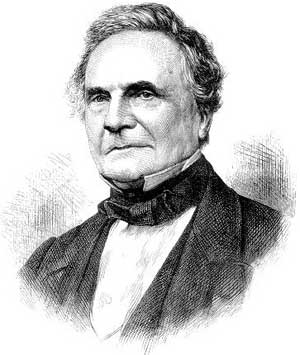
Charles Babbage, 1791-1871. Portrait from the Illustrated London News, Nov. 4, 1871
Differential Engine
A numerical table is a tool designed to save the time and labour of those engaged in computing work. The oldest tables which are preserved, were compiled in Babylon in the period 1800-1500 B.C. They were intended to be used for the transformation of units, for multiplication and partitioning, and they were inscribed in cuneiform on pieces of clay. During the beginning century B.C. Claudius Ptolemy in Alexandria created his theory nigh the motions of the heavenly bodies in a work which later came to exist known by the proper name of Almagest
They were to form one of the Ancient Earth'southward most important astronomical documents and they contained all the necessary tables for the calculation of eclipses as well equally various kinds of ephemeris, that is to say tables which specified the positions of the heavenly bodies during a particular period, e.g. each day for a whole year. During the first half of the thirteenth century the Ptolemy'southward tables caught the attending of Male monarch Alphonso the Wise of Castile. He then gathered together a great number of scholars in Toledo who were given the job of computing a new drove of astronomical tables. The reason for this endeavor was said to exist that King Alphonso, who was interested in astronomy, had discovered many errors in Ptolemy'due south tables. The piece of work began some time in the 1240s and took about ten years to complete. The tables produced were later known equally the Alphonsine Tables. The vast costs involved were paid for past the king, whose name soon spread with the copies of the tables throughout the European scientific world. Besides the Babylonian tables, Ptolemy'due south work and the Alphonsine Tables, a swell deal of toil went into the production of many other numerical tables of different kinds during this catamenia.
With the introduction of the art of printing throughout Europe during the latter half of the 15th century, the get-go tables were printed. The Alphonsine Tables for example, were printed in Venice in 1483. At the end of the sixteenth century, several famous arithmetical and trigonometric tables were published. In guild to simplify multiplication work, multiplication tables were published. A real revolution in the table business concern happened later John Napier's discovery of logarithms in 1614. With a table of logarithms at hand, the computational try could exist profoundly reduced. In 1617 Henry Briggs published the kickoff table of logarithms.
Two hundred years later, at the start of the 19th century, numerical tables were notwithstanding the most important calculating aid in Europe. The sole alternatives were Napier'southward Bones and the slide rule. Mechanical calculating machines were extremely rare and at about a handful of very select individuals tin e'er accept used them for serious calculations. Almost of them were simply remarkable gadgets illustrating man'south scientific progress, rather than genuine aids to calculation. For the normal calculator or scientist who had to bear out circuitous computations which demanded neat accuracy, Napier's Rods and the slide rule were of trivial aid. In effect, his tools were pen, paper and tables. There were tables for mathematics, astronomy, navigation, physics, engineering, statistics, trade and finance, in the regular army and in many other areas. The publication of such tables nonetheless required a lot of manual computing piece of work and the final product was total of errors.
Some fourth dimension in 1821, the young english mathematician Charles Babbage (biography of Charles Babbage) got the idea about the mechanical computation. He has provided us with two versions of the origin of his ideas about machines, simply the one written in 1822 seems more plausible than the other, which appeared in his autobiography some xl years later on.
Co-ordinate to the get-go story, in 1820 or 1821, the Astronomical Society assigned Babbage and his friend Herschel ane of the tasks for improving the tables of the navigational book Nautical Annual. They constructed the appropriate formulas and assigned the arithmetic to clerks. To diminish errors, they had the calculations performed twice, each by a different clerk. Then they compared the two sets for discrepancies. In the grade of their ho-hum checking, Herschel and Babbage plant a number of errors, and at ane point Babbage said I wish to God these calculations had been executed by steam. It is quite possible, remarked Herschel.
But in his autobiography Babbage remembered another version of the story, which must have happened either in 1812 or 1813:
"… I was sitting in the rooms of the Analytical Society, at Cambridge, my head leaning forward on the table in a kind of dreamy mood, with a table of logarithms lying open before me. Another member, coming into the room, and seeing me half asleep, chosen out, "Well, Babbage, what are you dreaming most?" to which I replied "I am thinking that all these tables" (pointing to the logarithms) "might exist calculated by machinery."
Whatever the truth, some time in 1820 or 1821 Babbage started his work on the calculating machine, making several designs for clockwork-like mechanisms, that could exist made to control a set of wheels with numbers along their edges that could print on paper. He made a modest model consisting of 96 wheels and 24 axes, which he later reduced to 18 wheels and 3 axes. The machine was set up by the end of the leap of 1822 and in June was announced publicly and has been examined by several of the members of the Astronomical Society.
Information technology seems Babbage must have known very lilliputian about auto design, mechanical calculating and the history of such machines at that time, considering he started by because the utilise of sliding rods, instead of the more than natural employ of wheels in the adding machinery. This kind of machinery which was "new" in the history of calculating machines, gives rise to grave difficulties in the process of carrying, a fact which Babbage somewhen realized. In fact this seems to accept been such a revelation to him, that in November of 1822 he noted very solemnly that he had in time to come decided always to choose round motion for this purpose.
The working model had a department of the calculating machinery, including two orders of divergence, just no press mechanism. He successfully calculated the first thirty values, arising from the formula + x + 41, which was a favorite example of his, because it generates a lot of prime numbers. The machine produced correct results at the charge per unit of 33 digits per minute, so the values were tabulated in two and a half minutes. Afterward on same year Babbage wrote a note to the Society and an article "On the Theoretical Principles of the Mechanism for Calculating Tables" for Brewster'south Periodical of Scientific discipline:
I have contrived methods past which type shall exist gear up by the machine in the order determined past the calculation. The arrangements are such that… in that location shall non exist the possibility of mistake in whatsoever printed re-create of tables computed past this engine.
Babbage wrote as well a letter on the general subject to the president of the Royal Society, Sir Humphry Davy. In this letter, Babbage pointed out the advantages such a car would have for the Authorities in producing the lengthy tables for navigation and astronomy, and proposed to construct a auto on an enlarged scale for the Government's use.
The Astronomical Lodge received Babbage's proposal with the highest enthusiasm, and the Regal Society reported favorably on his projection for building what he called a Difference Engine, a specialized calculating automobile for calculation of tables, using the method of differences
Babbage was not the first to suggest a printing computer, nor was he the outset to propose the method of differences as a suitable principle on which to base a mechanized calculation. This distinction goes to the german language engineer and master builder Johann Helfrich Müller, who described his dreams for calculating machine, based on the method of differences as early on in 1784, but his idea remained only on paper. There is an show, that at some betoken, Babbage learned about Müller and his project, but this virtually probably happened subsequently 1821, when he has already started his piece of work on Difference Engine
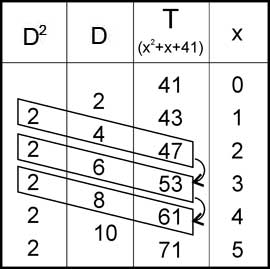 What is the essence of the method of differences, which underlies Babbage'southward get-go automatic computing automobile. Let's consider the same formula, used by Babbage: T=ten + x + 41. Information technology generates a sequence of values for , which happen to be prime number numbers, every bit seen in the table in the nearby effigy, in which with is noticed the outset difference cavalcade, while with —the 2nd difference cavalcade. If nosotros take the differences between successive values of , these and so called beginning differences follow quite a unproblematic dominion. If we take the differences between the differences, known equally the 2d differences, the consequence is fifty-fifty more than striking-the 2d difference, is a constant. With this knowledge, the table can be congenital up in a very simple way, as shown by the box in the table. Have the 2nd difference, and add information technology to the first difference to form a new first deviation, 4+ii=6. The process can exist generalized. In our instance the second deviation is constant because the function T is a quadratic. If the function T were a cubic, such as T = 10 , and then the 2d difference would vary, but the third departure, the departure between successive 2d differences, would be abiding. In general a polynomial of degree will take a constant norththursday departure and each successive new value of the part can be obtained past n uncomplicated additions.
What is the essence of the method of differences, which underlies Babbage'southward get-go automatic computing automobile. Let's consider the same formula, used by Babbage: T=ten + x + 41. Information technology generates a sequence of values for , which happen to be prime number numbers, every bit seen in the table in the nearby effigy, in which with is noticed the outset difference cavalcade, while with —the 2nd difference cavalcade. If nosotros take the differences between successive values of , these and so called beginning differences follow quite a unproblematic dominion. If we take the differences between the differences, known equally the 2d differences, the consequence is fifty-fifty more than striking-the 2d difference, is a constant. With this knowledge, the table can be congenital up in a very simple way, as shown by the box in the table. Have the 2nd difference, and add information technology to the first difference to form a new first deviation, 4+ii=6. The process can exist generalized. In our instance the second deviation is constant because the function T is a quadratic. If the function T were a cubic, such as T = 10 , and then the 2d difference would vary, but the third departure, the departure between successive 2d differences, would be abiding. In general a polynomial of degree will take a constant norththursday departure and each successive new value of the part can be obtained past n uncomplicated additions.
The usefulness of divergence techniques is profoundly increased by the fact that any department of a well-behaved continuous role tin can exist approximated by a polynomial. The shorter the section and the college the degree of the polynomial the closer the approximation. So if we wished to tabulate a function, such as a sine or the time of sunset, it is only necessary to divide the function into short enough intervals and observe a suitable approximating polynomial for each interval. The method of differences can then be used to tabulate the function throughout the interval. This process is known as sub-tabulation. Babbage realized that a car could bear out this sub-tabulation procedure. First, he needed a mechanism for storing, separately, the numbers corresponding to the values of the tabular value, the showtime difference, the 2d difference, etc. and a mechanism to add together each divergence to the value of the preceding difference.
In the process of designing and edifice his Difference Engine, Babbage required many accurate drawings of the parts. While using these drawings, he felt that they did not fully and adequately describe the mechanism. For a automobile with many parts moving in diverse means, the static drawings could only show the shape and organization of the parts. So Charles devised a system of mechanical annotation that would also indicate how the parts moved—their speeds and interconnections. Dissimilar the usual drawings, the note did not picture the shapes of the parts. Rather, information technology was a tabular array of numbers, lines, and symbols to describe the motorcar's deportment. Information technology was a general arrangement that could be used to depict whatsoever machine. Charles published a description of his mechanical notation in the Philosophical Transactions of the Royal Society in 1826 and later in 1851 (see Laws of mechanical annotation). Withal, this mechanical note did not ever come into widespread utilize.
In an interview held in 1823 betwixt Babbage and the Chancellor of the Exchequer, a rather vague exact agreement was made whereby the Regime would grant funds for the enterprise which was expected to have three years. His ain Astronomical Society was so impressed by the automobile, that it awarded him its starting time golden medal in 1824. In the aforementioned yr the British government advanced Babbage a fee of £1500, and he began to construct the full Difference Engine. Babbage needed a small manufacturing plant and competent workers, although initially ii rooms in Babbage'south house were converted into workshops and a third into a forge. He hired a good engineer—Joseph Cloudless, to maintain the mechanical works in his shop. By 1828, Charles had spent more than than £6000 on the construction, and the authorities had only reimbursed him for £1500. After a supportive study from Charles's friends in the Royal Society, the government agreed to make up the difference. But the piece of work went rather slowly.
The whole project was taking much longer than anyone had anticipated. While the fabrication of basic parts proceeded, shop patterns had to be drawn for others. The full set up of plans was not completed until 1830. By so, Clement'southward workers had produced many thousands of parts, but had done little assembly.
Shortly, Babbage and the government decided that the plans and associates should be moved out of Clement's shop. On Babbage's property was built a two-store fireproof workshop and a second building for the Divergence Engine. Babbage's intention was to move Clement's whole operation to these new quarters. Nonetheless, Cloudless resisted, because with the funds Babbage had supplied him, he had greatly expanded his own workshop. He now had many automobile tools and a number of employees and used them to do other work besides that contracted by Babbage. And by the trade practices of the time, he insisted that the machinery belonged to him, not to either Babbage or the government.
During 1832, Clement'southward workers completed the assembly of as much of the engine every bit they had parts for (some 10000 parts were made). Fifty-fifty though the computing section was largely complete, just the printing section was non. From this time on, no further work was done. Clement would not motion his mechanism to Babbage's store, and just in 1834 was the engine itself transferred. Past then, the government had expended £17000, and Babbage had spent some vi thousand pounds ain money. The government was unwilling to keep further, given the need to reorganize the whole project after Clement and Babbage had parted visitor.
Well-nigh all of the parts of the unabridged calculating mechanism had been made, just not assembled, when piece of work on the project stopped early in 1833. A portion of the calculating mechanism was assembled in 1832 (meet the lower photo) to demonstrate to a committee of the Imperial Social club and the Parliament that the project was proceeding satisfactorily, but it was limited to two orders of differences and five figures, suitable for demonstration purposes only.
Information technology is well-nigh 1-3rd of the pinnacle and one-one-half of the width, or almost one-seventh of the entire calculating machinery and consists of most 2000 bronze and steel parts. The calculating part alone would have been 7 times larger than the piddling unit that was assembled. The entire car was expected to incorporate some 25000 parts and to weight over 2 tons, with dimensions roughly 260 cm high, 230 cm broad, and 100 cm deep.

A role of Difference Engine, assembled in 1832
The Blueprint of the Difference Engine
The Difference Engine consisted of two major parts—the calculating mechanism and the press and control mechanism. In the lower drawing from 1830 of the elevation (upper part of the figure) and plan drawings (lower part) of Difference Engine they are clearly seen. The computing mechanism is on the left, the axes of figure wheels for the tabular value (far right) and 6 differences are clearly visible. The printing mechanism is on the right, and the moving table conveying the stereotype printing plate and the sector conveying the digit-type punches are visible in the centre of both drawings.
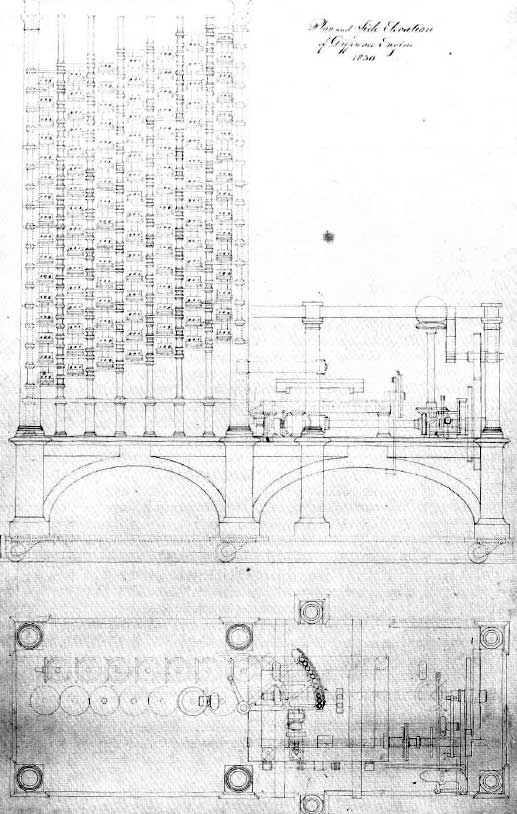
Elevation (upper part of the figure) and plan drawings of Deviation Engine, from 1830
Digits are represented in the Difference Engine by the rotational position of horizontal gear wheels. A number is made up of a series of these figure wheels rotating about a common vertical centrality. The bottommost wheel represents units, the next tens, the adjacent hundreds, and and so on. The figure wheels are about xv centimeters in diameter and are spaced vertically about vii.5 centimeters autonomously on the axes. Babbage used the term centrality to mean a stack of figure wheels that together shop a number as a drove of decimal digits. The unabridged Difference Engine consists of an axis for the tabular value of the role, some other centrality for the difference, a tertiary centrality for the second departure, so on for every bit many orders of differences as are desired.

A office of Deviation Engine (from the frontispiece of Passages from the Life of a Philosopher, 1864)
Each axis served not simply every bit a number store, just also as an calculation mechanism. Addition occurred in ii steps that volition exist explained with reference to adding the first departure to the tabular value. Inside each kickoff difference effigy bike there is a mechanism that is rotated through simply as many steps every bit the value stored by the figure wheel. If the units figure wheel stands at iii, the mechanism will motility through three steps. This motion is conveyed by gearing to the corresponding figure wheel of the tabular value axis. If the latter stood at five initially, it will be moved 3 steps to stand up at 8. This process occurs simultaneously in the tens, hundreds, thousands, and other digit positions.
It may happen that improver to a figure wheel will generate a bear that must exist propagated into the next higher digit position. If the units digit of the tabular value were initially 6 and 7 is added, it will motion forward vii places and come to stand at three, only a conduct must also be propagated into the tens figure bicycle of the tabular value. Carry propagation is complicated by the fact that if the tens figure wheel already stands at 9 it will be moved forrard by the carry to stand at 0 and a new comport will exist propagated into the hundreds figure wheel. In the Difference Engine these sequent carries may propagate, as on occasion they must, from the units up through the most meaning figure bike. Each improver, therefore, consists of two distinct steps-the simultaneous addition of all figures of the get-go deviation to the corresponding figures of the tabular value, and the sequent propagation of carries from the units up to the most pregnant digits as required.
 Tabulation of a part involves the repetition of this bones addition process for each of the orders of difference involved. As each axis is as well an calculation mechanism the tabulation of a cubic function from third differences, for example, requires vi steps for each tabular value produced (run across the nearby figure):
Tabulation of a part involves the repetition of this bones addition process for each of the orders of difference involved. As each axis is as well an calculation mechanism the tabulation of a cubic function from third differences, for example, requires vi steps for each tabular value produced (run across the nearby figure):
i. Improver of tertiary divergence digits to second difference digits
2. Deport propagation among second difference digits
3. The second divergence is added to the offset difference
4. Carry propagation amongst first difference digits
5. The first difference is added to the result column
half dozen. Carrying took place in the result column
Negative numbers may be handled with no additional mechanism past representing them as their ten's complements.
This scheme is readily extended to college order differences. Information technology is obvious that the number of steps is doubled number of the power of part, which means that for higher ability functions will be required a lot of steps. Babbage found a way to rearrange the adding so that only four steps were required for each tabular value produced irrespective of the number of differences involved. This is characteristic of the sophisticated logical considerations underlying Babbage's designs.
Babbage observed that when the fist difference is added to the tabular value, in steps five and half dozen, both the third difference and second divergence axes are idle. He could thus add the third difference to the second difference, steps ane and two, at the same time equally the outset difference is added to the tabular value. Steps one and two overlap steps five and six. Thus only four units of time, for steps three to half dozen, are needed for each tabular value produced. In modern terminology we would call the arrangement of hardware to perform a calculation in this way a pipeline
The overlapping idea can exist extended to college differences and a new tabular value can always be produced in iv steps, namely:
1. Odd differences are added to even ones and to the result.
2. Carrying takes place in the even differences and in the outcome.
3. Even differences are added to the odd.
four. Conveying takes place in the odd differences.
Not only does this rearranged class of the calculation salvage considerable time but information technology also makes the arrangements for driving the calculating machinery much simpler.
It appears every bit if Charles Babbage did non initially determine the mathematical capacity of the engine. He merely describes information technology as existence intended as a larger engine. In 1823 the engine was being fabricated to calculate with four orders of differences. The number of digits was not mentioned. In 1829 the machine was said to be able to operate with sixth order differences, 12 digits, and to print 16 digits in the result with speed forty-four digits a minute.. At some signal Babbage settled for 6 orders of differences, merely the number of digits connected to vary, depending on the author. eighteen digits are mentioned in 1834 and as an old homo Babbage himself said that the whole engine would have been capable of calculating with 20 places of digits.
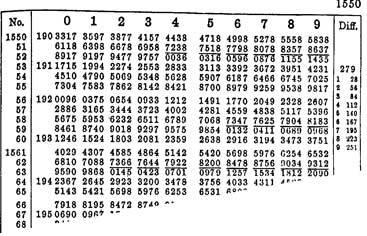 The matrices for the stereotyping of the tables would take been produced in the printing unit. The result was to exist taken from the result cavalcade in the calculating unit of measurement and transferred to the printing unit. There, eleven steel punches were supposed to print the result and statement in a copper plate, producing a printout like to this, shown in the nearby figure.
The matrices for the stereotyping of the tables would take been produced in the printing unit. The result was to exist taken from the result cavalcade in the calculating unit of measurement and transferred to the printing unit. There, eleven steel punches were supposed to print the result and statement in a copper plate, producing a printout like to this, shown in the nearby figure.
It is a swell pity that the piece of work on the Departure Engine ceased and so close to completion. Henry Babbage later estimated that only a further five hundred pounds would have sufficed. Babbage could readily have found the funds, however his feelings and attitudes to both the government and Clement could non allowed him doing and then. Besides that, inside a year or 2, Babbage's mind had moved a long way towards the much more complex and intellectually rewarding Belittling Engine. There was then no mode he would have returned to the original Divergence Engine pattern and brought information technology to completion, fifty-fifty had events made that feasible.
In late 1860s Babbage said: "I have non finished it [Difference Engine] considering in working at it I came on the idea of my Analytical Engine, which would practise all that it was capable of doing and much more than. Indeed the idea was so much simpler that information technology would have taken more than work to complete the calculating machine than to blueprint and construct the other in its entirety, so I turned my attending to the Analytical Machine."
Nevertheless it is out of question, that the Divergence Engine stood equally a great monument over man's ingenuity and ability to mechanize all kinds of labour. The idea was also of import and exciting to exist forgotten. Babbage's exertions brought in their wake considerable publicity, which was an important cistron in keeping the thought alive. Some other factor was naturally the problem itself. A handful of inventors, all with unlike backgrounds, were to endeavor during the course of the 19th century to build difference engines co-ordinate to their own ideas. First of them was the Swede Pehr Georg Scheutz, who managed only with pocket-sized part of Babbage's resources to produce a working difference engine in the middle of 19th century.
For some years, Babbage displayed the working department of his Difference Engine in ane of his drawing rooms and used the portion of the computing mechanism to calculate nearly a hundred functions. He fifty-fifty designed some improvements to the original machinery. In the Difference Engine, whenever a new constant was needed in a set of calculations, information technology had to be entered by hand. In 1834, Babbage conceived a way to have the differences inserted mechanically, arranging the axes of the Difference Engine circularly, so that the Consequence column should exist near that of the final Departure, and thus easily within reach of it. He called this arrangement the engine eating its ain tail. But this soon led to the idea of decision-making the car by entirely independent means, and making it perform not but Addition, only all the processes of arithmetic at will in any order and every bit many times every bit might be required. Piece of work on the commencement Difference Engine was stopped on 10 Apr, 1833, and the outset drawing of the Analytical Engine is dated in September, 1834.
After finishing of the work on the design of the Analytical Engine in 1847, Babbage turned to the blueprint of a Difference Engine No ii, exploiting the improved and simplified arithmetic mechanisms adult for the Analytical Engine. The logical blueprint was the same every bit for the before Difference Engine, but he employed simpler mechanisms for storing and calculation numbers and carry propagation. The press machinery was simplified so that a whole number was impressed on a printing plate as a single action rather than in a digit-by-digit manner. A conventional print copy, using inked rollers, was fabricated simultaneously. The command was arranged by a single barrel in a very straightforward way. The design and a consummate ready of drawings was prepared by mid-1848. These Babbage offered to the British government, evidently to satisfy a delivery he felt existed in consequence of the failure of the project to build the start Divergence Engine, but the authorities show no interest on the new blueprint.
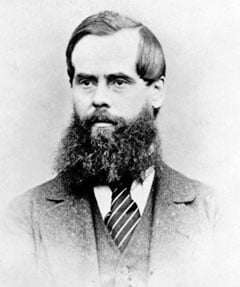 Babbage's calculating machines and related materials were inherited by his youngest son, Major-General Henry Prevost Babbage (1824–1918), who had shown a stiff interest in his father's work. While as teenager Henry and his older brother Dugald spent fourth dimension in Babbage's cartoon office and workshop learning workshop skills. Henry afterwards acquired a solid grasp of the Difference (and Belittling) Engine designs, and came to grade a close bond with his father whom he visited on furlough from extended armed services service in India. Babbage bequeathed his drawings, workshop and the surviving physical relics of the engines to Henry who tried to continue his father's work and to publicize the engines after Babbage'due south decease.
Babbage's calculating machines and related materials were inherited by his youngest son, Major-General Henry Prevost Babbage (1824–1918), who had shown a stiff interest in his father's work. While as teenager Henry and his older brother Dugald spent fourth dimension in Babbage's cartoon office and workshop learning workshop skills. Henry afterwards acquired a solid grasp of the Difference (and Belittling) Engine designs, and came to grade a close bond with his father whom he visited on furlough from extended armed services service in India. Babbage bequeathed his drawings, workshop and the surviving physical relics of the engines to Henry who tried to continue his father's work and to publicize the engines after Babbage'due south decease.
Henry was at his begetter'south bedside when Babbage died in 18 October, 1871, and from 1872 he continued diligently with his begetter's piece of work and then intermittently in retirement in 1875. He assembled some six minor demonstration pieces for Difference Engine Number one and one of them he sent to Harvard. In the 1930s the slice attracted the attending of Howard Aiken, the creator of the Harvard Marker I, a program-controlled calculator.
Believe just one-half of what you see and nothing that you hear.
Edgar Allan Poe
broadwaypapon1936.blogspot.com
Source: https://history-computer.com/differential-engine-history-of-charles-babbage-differential-engine/
0 Response to "When Was the First "Difference Engine" Developed, Whos Idea Was It, and What Was It Intended to Do?"
Post a Comment